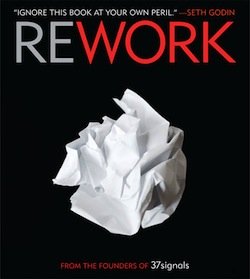|
Vision
The first element of your business strategy is vision. Outlining the dream gives you goalposts to aim for, and with a goal you’ve got something to call a “success”. Creating your vision involves three stages:
Dream BIG.Its important to think big. Stretch the boundaries of what’s possible, and come up with a remarkable idea and project. There are no limits on your imagination. Dream BIG. It’s how good you want to be” A great little best-seller by Paul Arden (here's a slideshow showing his core ideas) and great for helping you define and explore your vision. There’s so much truth in that title, especially when you’re young. You still know how to dream BIG. Teen businesses don’t have to be just mowing lawns or selling lemonade. Remember what you dreamt about when you were six, seven or eight. You know how to dream big.
One Long Shot, Three Fish In a BarrelImagine a shotgun; your targets right on the edge of its range. You’ve got only a couple of shots, if that. Maybe you might be able to walk closer and take a pop, but that’ll take time. That long shot is the big dream. And yes, its maybe a little farfetched. That’s why you need your ‘certain wins’ - your fish in the barrel. Three of them. These smaller, more certain wins help you move towards that big goal. The profits, the learning from small success and the motivation of jumping hurdles. Three fish in a barrel might include paid consulting around your area of expertise, blogging about what you’re doing then packaging your best advice into a book and sharing your ideas and expertise. Famous chefs give away their best recipes, but they’re still in business the next day. When Do I Become "Successful"?A fascinating thing happens when you get near your goals and objectives though. The persuit of your vision changes. Suddenly its something else, just on the horizon. This persuit of vision is what drives entrepreneurs - they can see their idea alive, now its just up to them to get there. - Simon Sinek But in order to make something happen, and turn your vision into a reality, you need to go beyond “thinking big”. You need to think realistic - what do you need to do to put your first foot forward and get started? Get Real.Literally, “get real”. What’s the minimum you need to make this work? What can you chop and change? What can’t you live and do without? It turns out coming up with a good idea isn’t that hard. What’s hard is making the next step - getting real is one of the toughest processes, especially for the visionary. Getting real is understanding what it takes to get your project and idea off the ground now. Getting real is ignoring the doubters, creating an action plan and making your idea realistic.
How can you share your vision with other people so they feel compelled to follow and work with you to make it happen? What’s in it for them? It’s much easier to turn pipedreams into a reality when you’ve got more than one pair of hands. The folks at 37signals wrote a book on ‘Getting Real’, written for software and web app developers - but there are gems in there for everybody. Seriously. Ship It.This is the hardest part of your vision. Shipping. Shipping, in the broad sense, means getting something out the door; “Make it happen” as my Dad says. Shipping is anything from doing the washing up to sending an email to launching a new product. Shipping gets harder and harder the more something matters. It’s what’s known as the resistance. Procrastination, nerves and that voice in the back of your head yelling “people are going to laugh at you. What the hell are you doing?!” - they all form the resistance. They're the CRAP - the Criticism, the Rejection, the Ass-holes and the Pressure. The resistance will force you to over-compromize and “make do”. The resistance will turn your dream that kept you wide awake at night when it was first conceived in your mind, into mediocrity. Few people push through the resistance. Its hard. That’s why you hear so few remarkable stories of success. Success follows people who have persisted with fighting the resistance; that’s what persisting is. An ongoing war.
Failing Your Way to SuccessMany entrepreneurs will argue that you need to fail first before you succeed - its a learning experience they say. Two things here; its one thing having a failing project, and a totally different thing to have a failing company. Apple is successful, despite having its share of flops. But a failed company is just that - a failure. How would that be a good thing? Surely the best thing is to learn from success, and this is the second point. You’re not accountable for other people’s failures, so why should “learning from failure” be a path to success. Just because other people fail on the way, doesn’t mean you should. Doing Justice to Your IdeaIdeas are fiction. Success is reality. Your ideas want to become a reality, so if you don’t “make it happen” your doing your ideas an injustice; similar starving a small child. Yeah, serious stuff... Your ideas matter. You need make them happen. Don’t procrastinate. Do justice to your ideas by making them happen now.
Go to the Next Chapter: Leverage Your StrengthFocusing on what you're good at, you'll get more done. Here's the thorough guide to identifying and leveraging your personal strengths. Return from Your Vision to Your Teen Business
|
Go to the Next Chapter
-
Your Vision
Why dreaming big can have such a huge impact on your business, but how "getting real" is what will make your dream a reality. -
Personal Strengths
How and why to build a business based on your personal strengths, why you should embrace your limitations and how to maximize your talents. -
Passion
Passion is that unusual force that means you wake up in the morning; here, you'll learn why money doesn't equal passion, how to find your passion and what to do with it. -
Resources
How to get all the people, the money, the kit and the training you need to make your business actually happen. Without this, you'll be forever frustrated. -
Business Mentors
Having experienced experts guiding you through this whole "business" landscape is the single fastest-accelerator for your teen business. Discover the secrets to successful networking here. -
Masters of Marketing
Marketing is the single most misunderstood part of everyday business. Here, get introduced to the Masters of Marketing who will really teach you how to win customers. -
Make It Happen!
Its great having a strategy to this elaborate business of yours, but its another thing to actually make it happen. This is your guide to getting things done

Join the community of teenage entrepreneurs at Teen Business Forum - and be sure to check out the Teen Business Forum blog too.

The ideas in this guide were inspired by lots of different books and videos, but none more so than Rework. Written by the guys at 37signals
Here's a quick summary by Jason Fried of what's in the book
It was also heavily influenced by Cameron Herold's TEDxTalk on Raising Kids to Be Entrepreneurs






